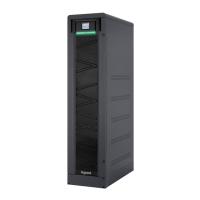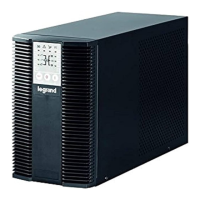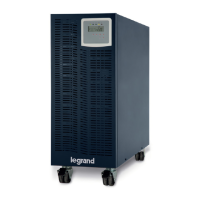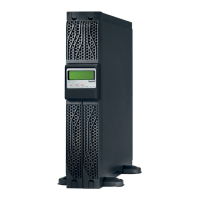38
9. Troubleshooting
The aim of this chapter is to identify potential issues, understand the root cause of the problems and
provide solution to them.
9.1. Bypass Voltage Failure Alarm
It means that auxiliary mains supply voltage is out of the limit.
Make sure that the auxiliary mains supply circuit breaker is “ON” and the voltage / frequency is between the
bypass limit.
9.2. Bypass Phase Sequence Wrong Alarm
It means that phase sequence of auxiliary mains supply voltage is not OK. Phase sequence of the auxiliary
mains supply should be changed. Please contact the LEGRAND Technical Assistance Centre.
9.3. Inverter not sync. with bypass Alarm
Frequency of auxiliary mains supply voltage is beyond the frequency range for online operation or auxiliary
mains supply voltage is out of limit. Check if the auxiliary mains supply voltage is in specied limits.
9.4. Input phase sequence wrong Alarm
It means that phase sequence of common mains supply voltage is not OK. Phase sequence of common
mains supply input should be changed. Please contact the LEGRAND Technical Assistance Centre.
9.5. Rectier Not Sync. with Input Alarm
Frequency of common mains supply voltage is beyond the frequency range of rectier or common mains
supply voltage is out of limit. Check if common mains supply is in specied limits.
9.6. Dc Voltage Failure Alarms
Any of the DC bus voltages is out of the limit. If you encounter this alarm during start-up, check if the
inrush circuit breaker is at “ON” position. Check polarity of external battery connections if any. If it still exists
contact the LEGRAND Technical Assistance Centre.
9.7. ESD active Alarm
It means that Emergency Switching Device (ESD) is activated (digital input “UPS OFF” is set high). Check if
ESD switch is ON or not.
9.8. Ambient temperature high Alarm
It is shown “Ambient temperature high” on Diagnostics Menu. If the ambient temperature is high, it
causes a rise in the internal temperature of UPS and this alarm appears. In this case; the rst thing to do is
cool the environment.
9.9. Overload Alarms
Loads connected to the output of the UPS exceed the nominal power of the unit so it gives “Rectier
overload” and/or “Output overload” alarms. Check if there is an overload and origin, remove the excessive
load. Hence the alarm would switch to o.
Residual voltage and high temperature metal parts inside even if the UPS is
disconnected. Contact may cause electric shock and burns. All operations except
replacing battery fuses shall be carried out by the authorized Legrand UPS
Technical Service Personnel only.
Make sure that the UPS is not overloaded to provide a higher quality supply to
the loads.
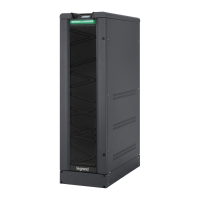
